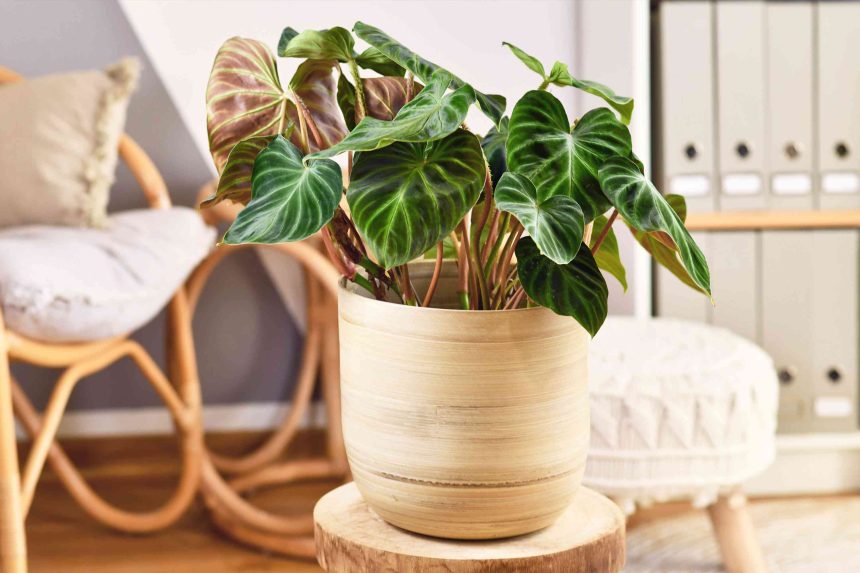Philodendrons are beautiful plants found growing in the understory of tropical forests in Central and South America. These stunners are one of the most popular houseplants, thriving in spaces with high humidity, bright sunlight, and warm temperatures. If you love your philodendrons and want more of them in your home, propagation is an easy way to achieve this. Philodendrons can be propagated in three ways—by rooting stem cuttings in water or soil and by air layering. Ahead, horticulturists explain how to propagate philodendron for an endless supply of plants.
When to Propagate Philodendron
Philodendrons can be propagated pretty much any time of year. “That said, the warm, humid months of spring and summer tend to make for easier propagation because of temperature and humidity levels, as well as higher light levels,” says Justin Hancock, horticulturist for Costa Farms. “But you can propagate in the middle of winter, too,” he says, adding that it may take longer and you may see a lower success rate.
How to Propagate Philodendron in Soil
Propagating philodendron in soil is one of the easiest and most successful methods. Choose a well-draining, all-purpose potting mix or make your own with a mix of sand, perlite, and vermiculite, says Hancock. “You might want to experiment a little and see what works best for you and your conditions,” says Hancock.
- Cut a philodendron stem that is 4 to 6 inches long with several leaves on it, cutting the stem below the lowest node.
- Remove the lower leaves. Two to three leaves should remain on the cut stem.
- Dip the cut end of the stem in rooting hormone.
- Fill a small container with potting soil. Poke a hole in the soil with a pencil or your finger.
- Place the cutting in the hole. Pinch the soil around the base of the cutting to ensure there is good contact between the stem and the soil.
- Place the container in an area that receives indirect light. Roots should begin to form in three to four weeks.
Once the cuttings are well rooted, they can be teased out of the soil and planted in individual pots and watered, says Andrew Bunting, vice president of horticulture at the Pennsylvania Horticultural Society.
How to Propagate Philodendron in Water
You can also propagate philodendron in water, which allows you to see the roots as they grow. Hancock notes that he prefers soil propagation and hasn’t had much success with rooting cuttings in water. Change the water out every few days to prevent algae and bacteria from building up.
- Cut a philodendron stem that is 4 to 6 inches long with several leaves on it, cutting the stem below the lowest node.
- Remove the lower leaves. Two to three leaves should remain on the cut stem.
- Fill a small container with water. Place the cutting in the water, making sure none of the leaves are submerged.
- Place the container in an area that receives indirect light. Roots should begin to form in three to four weeks.
- When there is an ample root system, transplant the cutting into a new pot with well-draining potting soil.
- Water well and place the container in an area that receives indirect light.
How to Propagate Philodendron by Air Layering
If you want to try an advanced propagation technique, you can propagate your climbing Philodendron by air layering it, says Hancock. Air layering is a propagation method that encourages roots to form on a stem that is still attached to the parent plant.
- Using a sharp knife, make a little notch—less than a 1/4-inch deep—into the stem just below a leaf.
- Remove the leaf right above where you made your notch and wrap the branch in moist sphagnum moss.
- Wrap the moss with aluminum foil or plastic wrap to keep it in place.
- Keep the sphagnum moss moist, spritzing it a couple of times a week. It should root after a few weeks.
- Once roots are 2 to 3 inches long, cut the branch off below the roots and transplant it into a new pot with well-draining potting soil.
- Water well and place the container in an area that receives indirect light.
How to Care for Cuttings After Propagation
Giving your cuttings adequate care after propagation will give them the best chance of rooting successfully. “Warm, humid conditions are best since the plant doesn’t have a root system to absorb water and the cutting needs lots of energy to produce new roots,” says Hancock. “Also, be sure to never let your cuttings dry out—without roots, they’re much more susceptible to dying from drying out than an established, rooted plant.” Ensure your cuttings are in a location where they receive bright, indirect sunlight.
When to Transplant Cuttings
Transplant the cuttings once they are well rooted. “Each cutting should have many roots that are over 1 inch long,” says Bunting. Fill a container with well-draining potting soil and dig a hole in the soil. Place the roots in the hole and push the soil around the roots, covering the base of the cutting. “Water and put in indirect sunlight. It is important for the first month, while the plant is establishing, to keep it moist, but not too wet,” says Bunting.








